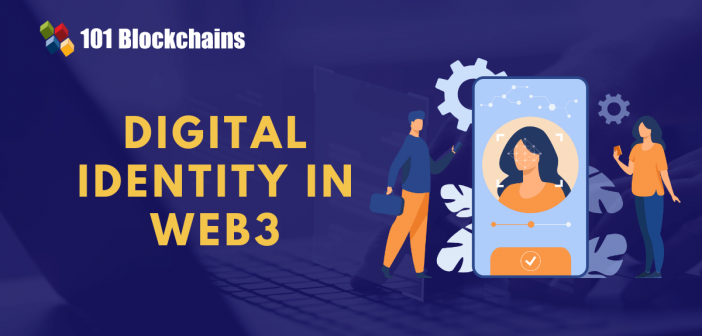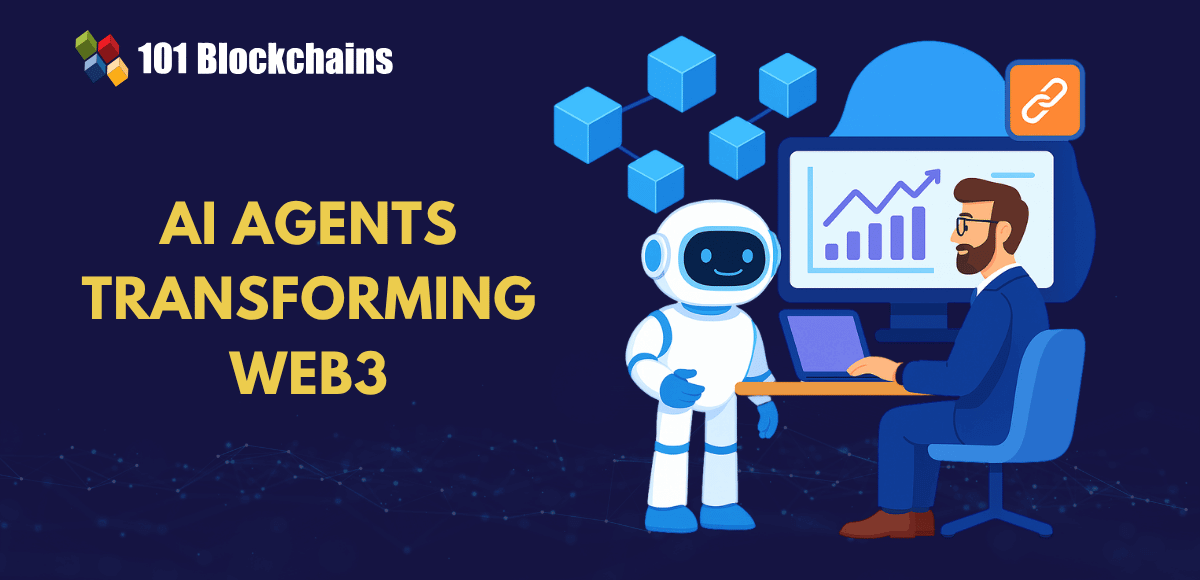Learn how blockchain truly works, master key definitions, and uncover what makes smart contracts so "smart." Dive into the fundamentals, gain valuable insights, and start your blockchain journey today!

- Web3
James Howell
- on February 17, 2023
Digital Identity: Why It Matters in Web3
The existing state of transition towards the decentralized digital revolution emphasizes the necessity of learning about web3. Businesses and individual users are gradually noticing the advantages of web3 technology along with profound growth in the number of web3 services. Therefore, the concerns regarding digital identity in web3 have become one of the top priorities in discussions revolving around web3.
You must have learned about the different setbacks in existing web2-backed internet. Some of the prominent highlights, such as social media addiction and disastrous data breaches, have affected the digital experiences of users. The evolution of the internet with the help of blockchain focuses on reshaping the fundamental mechanism of the working of internet.
You might wonder about the relevance of web3 digital identity in the journey of evolution of the internet. Digital identities would be one of the core elements of web3 and serve a crucial role in governing web3 interactions. On top of it, digital identities can also create the foundation for almost everything in the web3 landscape, including financial transactions and interactions with the metaverse. The following post offers an introductory guide to digital identity in web 3.0 and how it works.
Brief Overview of Web3
The answers to “What is digital identity in web3?” would be incomplete without referring to the basic explanation for web3. The origins of the term ‘web3’ started off with the innovative developments in blockchain technology. Ethereum co-founder and Polkadot founder Gavin Wood coined the term in 2014.
Gavin Wood had described web3 as a decentralized online ecosystem operating on the foundations of blockchain technology. The term ‘web3’ garnered significant popularity with the consistent growth in venture capital pouring into the crypto domain. Experts have also hailed web3 as one of the favorable solutions for facilitating web regulation.
The digital identity blockchain equation fits perfectly within the scope of web3 for different reasons. Within the existing web2 landscape of the internet, tech giants take control over the massive repositories of data. On the other hand, web3 provides the advantages of decentralization by empowering the customers. Blockchain technologies serve as one of the integral blocks for enabling decentralization. Some of the notable concepts involved in web3 include the following,
- Non-fungible tokens or NFTs provide the flexibility for tokenizing assets and using them in different ways with the facility for faster verification of ownership.
- Decentralized Autonomous Organizations or DAOs, help transform traditional organizations by introducing decentralized ownership and governance of communities. As a result, DAOs could empower the members of web3 organizations.
- The next vital component draws attention toward web3 identity, which can support customers with authentication and verification without disclosing their personal information.
- Finally, another crucial highlight in the web3 landscape points to DeFi or decentralized finance, which democratize finance. The examples of popular decentralized lending and borrowing protocols prove how DeFi has grown as a crucial element in web3.
Curious to develop an in-depth understanding of web3 application architecture? Enroll Now in Web3 Application Development Course!
Definition of Digital Identity in Web 3.0
The strength of web3 is evident in how it empowers users rather than favoring big corporations. Web2 depends on centralized data repositories for authentication. For example, if you have to open a bank account, you have to verify your identity. Banks would allocate the identity verification task to a third-party service provider, who could access sensitive information about users. Therefore, there is no specific consensus regarding who can access your data and the places where your data is stored.
In the case of web3, digital identity verification in blockchain helps in avoiding problems with centralized identification processes. Centralized identity verification involving storage of private information with third parties has prompted a sporadic rise in data breaches. On top of it, identity theft cases have proved that centralized authentication mechanisms are not immune to forgery. How does web 3.0 identity solve these problems?
The foremost highlight of a digital identity example in web3 would reflect on decentralized management of digital identity. How can you characterize web 3.0 identity? Here are the most notable traits you can find in web 3.0 identity.
- Users have control over their own data and information without relying on centralized agencies such as corporate institutions and governments.
- Users could create digital identities, which are associated with their real-world identities, alongside ensuring anonymity.
- One of the significant highlights of digital identity in web3 refers to compliance with principles of security, freedom and privacy.
The web 3.0 digital identity system has everything required for revolutionizing the traditional approaches to interacting with the internet.
Excited to learn the concept of decentralized identity on existing digital ecosystems? Enroll in Decentralized Identity Fundamentals Course Now!
What are the Top Existing Issues with Digital Identity?
The basic description of digital identity points to a specific set of digital information about an individual, electronic device or organization. Digital identity offers an effective instrument for authenticating access to digital services and products. Some of the most prominent highlights in a digital identity example would include the following.
- Usernames
- Browsing history
- Identifiers required for digital signature of documents
- Social media history
Most digital identity management systems follow centralized or federated approaches for managing online identities. Centralized identity management systems involve a specific organization taking control over storage and management of all digital identities in one location. The common examples of centralized digital identifiers include usernames, passwords and usernames. The necessity of web3 digital identity becomes clear with the evaluation of common issues with centralized digital identity management systems. Some of the prominent existing issues with digital identity include the following,
- Users need to manage different individual login credentials for each website and application.
- Centralized storage systems for user identities can create a single point of attack for hackers, thereby leading to data breaches. Many examples of data breaches in the recent past have showcased the detrimental impact on personal data of users.
- The need for digital identity blockchain solutions is also evident in the problems of centralized identity management systems for storage, use and sharing of personal data.
- It is also important to note the lack of privacy in centralized identity management systems, owing to the accessibility of personal data for centralized institutions. Therefore, centralized institutions could have the privileges for tracking online activities of people.
Interestingly, the problem of multiple identity verification credentials can be solved through a federated identity system. The federated identity system points to a system that can help users in accessing multiple applications through a single credential. For example, you can use Facebook or Google account to log in to another website or application.
The facility of single sign-on or SSO can offer convenient results by ensuring accessibility of websites and applications without creating a new account. Why would you need digital identity in web3 when you have federated identity systems? The answer would direct us toward the following problems evident in federated identity systems.
- The connection between multiple data sources with federated identity management systems creates more vulnerable spots for data breaches.
- Sharing user information with third parties could compromise the privacy and safety of users.
How Does Web3 Identity Solve the Problems with Digital Identity?
The detailed overview of the problems associated with digital identity example in centralized systems validates the importance of web 3.0 identities. You can resolve the issues with centralized identity management systems with the following features in web 3.0 digital identity.
Complete ownership and control of a single user, which could be an individual or an organization.
Decentralized storage of data in web3 identity ensures better security than centralized identity management systems. Storage of identity data on a distributed ledger across all user devices creates difficulties in compromising sensitive information.
Users could rely on a single set of credentials for secure login privileges on different apps and websites. The user experience with digital identity management in web3 is seamless, as you don’t have to manage multiple accounts and passwords.
Another important benefit of digital identity verification in blockchain points to the assurance of privacy. Users can authenticate their identity without the need to reveal sensitive information such as name, address or bank account numbers.
Excited to develop a comprehensive understanding of Polygon web3 development? Enroll Now in Polygon Web3 Development Course!
Working of Web3 Identity
The different advantages and value propositions with digital identity in web 3.0 showcase the ideal approaches for transforming identity management. In the case of web2, centralized digital identifiers such as emails, passwords, usernames and other sensitive information are required for accessing apps and websites. However, the identifiers create many vulnerabilities. How does digital identity in web3 work for solving the problems? The answer would point to three distinct elements, such as decentralized identifiers, blockchain technology and verifiable credentials.
Learn the fundamentals, challenges and use cases of Web3.0 blockchain from the E-book: An Introduction To Web 3.0 Blockchain
-
Decentralized Identifiers
Decentralized identifiers, or DIDs, are exclusive resources for proving your identity online without relying on centralized authority. You can find universally unique, verifiable and permanent identifiers you can store on blockchain networks. As a matter of fact, decentralized identifiers serve as the foundations of web3 digital identity, as you can prove your identity without divulging personal information. Web3 applications could use decentralized identifiers to confirm your identity while offering better control over your personal information. You can also determine who could have access to your personal information.
-
Verifiable Credentials
Another crucial aspect in the working of digital identity blockchain points to Verifiable Credentials or VCs. The Verifiable Credentials offer a digital and cryptographically secure variant of digital and physical credentials which can verify user identity. Some of the popular identity documents which you can issue as Verifiable Credentials include driver’s licenses, employee certificates, membership certifications and digital passports.
-
Role of Blockchain in Web3 Identity
Most of the discussions around “What is digital identity in web3?” draw attention to the role of blockchain technology. Blockchain offers a digital record of transactions without any centralized authority. As a result, users would have more control over using their personal data with the help of blockchain technology. In addition, blockchain also resolves the problems of a single point of failure in centralized identity management systems.
The use cases of web3 identity reveal how it matters for the growth of web3. Organizations can use web3 identities to improve data security and ensure better user experiences with assurance of privacy. On the other hand, individual users could capitalize on the benefits of flexible access and improved security alongside better control over their data. Web3 identities could help in creating immutable identities and open new doors for verifiable access to metaverse platforms.
Want to build your fluency in advanced technologies and develop decentralized solutions for the emerging web3 ecosystem as a web3 expert. Enroll Now in Web Expert Career Path
Final Words
The improvements in digital identity management systems with web3 can introduce many value-based advantages for individual users and organizations. As the world prepares for web3 adoption, digital identity in web3 can play a crucial role in developing trust in web3 use cases. Without the intervention of centralized agencies such as top tech corporations in their digital experiences, users are likely to embrace web3 solutions.
Interestingly, digital identities in the web3 landscape would serve as a single key for users to access the web3 ecosystem. Learn more about the use cases of web3 identities alongside examples and their future prospects right now. Explore the best learning resources to build your expertise in web3 and certify your skills with industry-recognized certifications now.
*Disclaimer: The article should not be taken as, and is not intended to provide any investment advice. Claims made in this article do not constitute investment advice and should not be taken as such. 101 Blockchains shall not be responsible for any loss sustained by any person who relies on this article. Do your own research!







